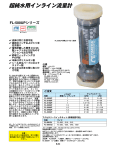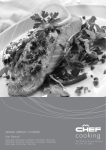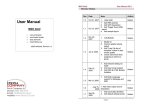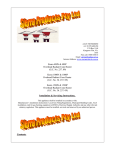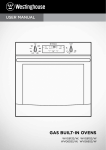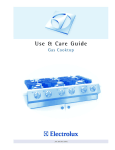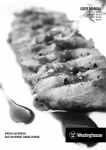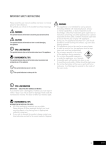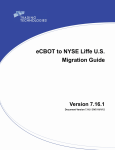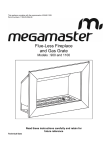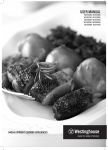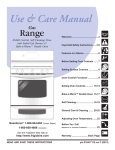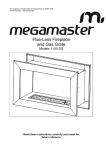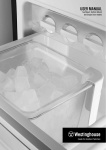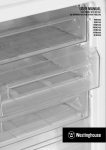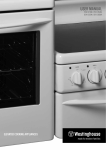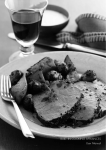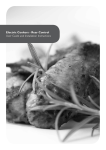Download User manual
Transcript
OWNER’S MANUAL 540 UPRIGHT COOKING APPLIANCES congratulations Contents Congratulations and thank you for choosing our Westinghouse upright cooker. We are sure you will find your new appliance a pleasure to use and a great asset to your cooking. Before you use the appliance, we recommend that you read through the whole user manual which provides a description of the product and it’s functions. General safety......................................................................................3 To avoid the risks that are always present when you use an appliance, it is important that the appliance is installed correctly and that you read the safety instructions carefully to avoid misuse and hazards. For future reference, please store this booklet in a safe place. Cooking guide & baking problems.....................................................11 conditions of use This appliance is intended to be used in household and similar applications such as: • Staff kitchen areas in shops, offices and other working environments • Farm houses • By clients in hotels, motels and other residential type environments • Bed and breakfast type environments. Description of cooker and controls......................................................5 Before operating your appliance for the first time................................8 Using the oven.....................................................................................9 Using the grill....................................................................................13 Using the hotplates............................................................................15 Clocks & Timers.................................................................................18 Get to know your oven........................................................................19 Service fuse, oven light replacement.................................................20 Fitting oven accessories and cleaning...............................................21 Solving problems...............................................................................24 Installation.........................................................................................26 Warranty.............................................................................................33 Record model and serial number here: Model:............................................................................................ Serial number:................................................................................ Please read the user manual carefully and store in a handy place for later reference. The symbols you will see in this booklet have these meanings: TIPS and & INFORMATION tips information WARNING warning This symbol indicates information concerning your personal safety WARNING caution This symbol indicates information on how to avoid damaging the appliance TIPS & INFORMATION tips and information This symbol indicates tips and information about use of the appliance environmentalTIPS tips ENVIRONMENTAL This symbol indicates tips and information about economical and ecological use of the appliance CONTENTS 2 Important – check for any damage or marks If you find the appliance is damaged or marked, you must report it within 7 days if you wish to claim for damage/ marks under the manufacturer’s warranty. This does not affect your statutory rights. environmental tips ENVIRONMENTAL TIPS Information on disposal for users •Most of the packing materials are recyclable. Please dispose of those materials through your local recycling depot or by placing them in appropriate collection containers. •If you wish to discard this product, please contact your local authorities and ask for the correct method of disposal. An important read to avoid an electric shock or fire Meanings of symbols used in this manual are shown below: This symbol indicates never to do this This symbol indicates always do this This appliance is not intended for use by persons (including children) with reduced physical, sensory or mental capabilities, or lack of experience and knowledge, unless they have been given supervision or instruction concerning use of the appliance by a person responsible for their safety. WARNING - Accessible parts may become hot during use. To avoid burns, young children should be kept away. Oven warnings DO NOT use oven door as a shelf. DO NOT push down on open oven door. If the gas oven does not light in 8 seconds, allow 1 minute for gas to clear before trying again. DO NOT line oven with foil or place anything on the bottom of the oven while baking, as trapped heat will crack or craze the floor of the oven cavity liner. DO NOT use poly-unsaturated oils (vegetable oils) as this type of oil can cause black spots or deposits inside the oven. This residue is very difficult to remove. Hotplate and burner warnings DO NOT allow pots to boil dry, as damage to hotplate may result. Young children should be supervised to ensure they do not play with this appliance. DO NOT operate without a pot, fry pan etc on hotplates. During use this appliance becomes hot. Care should be taken to avoid touching hot external and internal surfaces when in use. Use oven gloves. DO NOT allow cookware to overhang hob onto adjacent bench tops, this will cause scorching to the bench top surface. This appliance must NOT be used as a space heater. Gas models: Ensure burner caps and crowns are in their correct position. Do Not install gas models in marine craft, caravans or mobile homes because these products are not fitted with a flame safeguard on each burner. DO NOT spray aerosols in the vicinity of this appliance while it is in operation. O NOT store flammable materials in the appliance or D near this appliance. Ensure all specified vents, openings and airspaces are not blocked. Ceramic If the ceramic glass is accidentally cracked switch off the appliance to avoid the possibility of electric shock. DO NOT place heat resistant mats, wire mats or aluminium foil under pots or pans. DO NOT cook food directly on the ceramic glass surface. Install cooker, shelving and fittings in accordance with the Guide and Installation Instructions, to avoid accidents. DO NOT use round bottom woks or similar utensils which could lead to over heating of hotplates and possible damage to the cooking surface. DO NOT operate the gas appliance if the smell of gas persists. DO NOT use the ceramic cooktop as extra bench space or as a cutting board. DO NOT MODIFY THIS APPLIANCE. Grill warnings DO NOT leave grill on unattended. Fat left on a grill dish is a fire hazard! Keep grill clean and turn off grill immediately after use. If gas burner does not light in15 seconds, allow one minute for gas to clear before trying again. Placing thick portions of food under grill can be a fire hazard. DO NOT cover the grill dish insert with foil. Separate grill model: Grill with door open Grill in oven model: Grill with door closed 3 SAFETY An important read to avoid an electric shock or fire Installation, Cleaning and Servicing An authorised person must install this appliance. (Certificate of Compliance to be retained) Before using the appliance, ensure that all packing materials are removed from the appliance. In order to avoid any potential hazard, the enclosed installation instructions must be followed. Ensure that all specified vents, openings and airspaces are not blocked. In order to avoid accidental tipping of the appliance (for example, by a child climbing onto the open oven door), the anti tilt plate must be installed. Where the appliance is installed next to cabinets, the cabinet material must be capable of withstanding 85 deg C. Only authorised personnel should carry out servicing. (Certificate of Compliance to be retained) Always ensure the appliance is switched off before cleaning or replacing parts. If this appliance is gas operated it contains aluminium fittings. DO NOT use caustic based cleaners. DO NOT use steam cleaners, as this may cause moisture build up. Always clean the appliance immediately after any food spillage. To maintain safe operation, it is recommended that the product be inspected every five years by an authorised serviceperson. To be serviced only by an authorised person. Appliances requiring connection to 230-240V must be earthed. DO NOT install gas models in marine craft, caravans or mobile homes because these products are not fitted with a flame safeguard on each burner. SAFETY 4 Description of electric cooker with separate grill Fan Forced & Conventional Oven 1. Hob 2. Removable Spill Tray (Radiant Hotplate Models Only) 3. Removable Grill Dish Side Support 4. Grill Door 5. Removable Shelf 6. Oven Inner Door Glass (where fitted) 7. Oven Door 8. Control Panel 9. Flue Vent 10.Grill Element & Removable Grill Element Reflector 11. Removable Grill Dish & Rack 12.Oven Element (conventional models only) 13.Fan & Element Cover (fan forced models only) 14.Oven Element (fan forced models only) 15.Hidden Oven Element (conventional models only) 16.Rear Adjustable Feet 17.Anti-tilt Plate 18.Removable Kick Panel 19.Front Adjustable Feet 8. 1.Hotplate Control Knob •Adjusts temperature of hotplate. Can be rotated in either direction. 2.Hotplate Indicator Lamp (where fitted) • Comes on when a hotplate is turned on. 3. Oven light switch (where fitted) • Turns oven light on/off. 4.60 Minute Ringer Timer (where fitted) •Sets reminder time. 5.Grill Temperature Control Knob •Sets grilling temperature for separate grill. Can be rotated in either direction. 6.Grill Indicator Lamp • Comes on when grilling. 7.Oven Temperature Control Knob •Sets temperature for baking. 8.Oven Indicator Lamp •Comes on when the oven temperature control knob is operated. Cycles on and off automatically when baking. 9.Programmable Clock • Sets baking/grilling reminder times. • Sets automatic cooking duration and stop time. Note: Clock time must be set before oven can operate. 9. 1. 2. 10. 3. 11. 4. 12. 5. 13. 12. 14. 6. 7. 15. 16. 17. 18. 19. 5 DESCRIPTION Description of gas cooker 1. Hotplate Burner Control Knob •Sets the hotplate cooking temperature. 2.Grill Burner Control Knob •Sets the grilling temperature. 3.Oven Burner Control Knob •Sets the baking temperature. 4.Electronic Igniter Switch (where fitted) •Ignites the hotplate burners, grill burner and oven burner Note: The appropriate burner control knob has to be set first. 5.Fan Switch (where fitted) • Turns oven fan on/off. 6.Light Switch (where fitted) • Turns oven light on/off. 7. 60 Minute Ringer Timer (where fitted) •Sets reminder time. 8.Manual Grill Igniter Button • Ignites the grill burner. Note: The grill burner control knob has to be set to “High” first. Fan Forced & Conventional Oven 1. Removable Trivet 2. Removable Hotplate Burner 3. Control Panel 4. Removable Grill Dish Side Support 5. Grill Door 6. Removable Shelf 7. Oven Door 8. Oven Door Glass 9. Splashback 10.Flue Vent 11.Hob 12.Grill Burner 13.Removable Grill Dish and Rack 14.Fan Cover (fan forced ovens only) 15.Oven Burner Cover 16.Rear Adjustable Feet 17 Anti-tilt Plate 18.Removable Kick Panel 19.Front Adjustable Feet 9.Manual Oven Igniter Button • Ignites the oven burner. Note: The oven burner control knob has to be held down first. Manual Ignition Models 9. 10. 1. 2. 11. 3. 12. 13. 4. 5. 14. Electronic Ignition Models 6. 8. 15. 7. 16. 17. 18. 19. DESCRIPTION 6 Description of electric cooker with grill in oven Conventional Oven 1. Control Panel 2. Hob 3. Removable Inner Door Glass 4. Oven Door 5. Power Outlet 6. Power Outlet Switch 7. Flue Vent 8. Grill and Oven Elements 9. Removable Grill Dish & Rack 10.Removable Shelf 11.Hidden Oven Element 12.Rear Adjustable Feet 13.Anti-tilt Plate 14.Removable Kick Panel 15.Front Adjustable Feet 1. 5. 6. 2. 7. 8. 9. 10. 3. 4. 11. 12. 13. 14. 15. 2 3 7 OFF OFF OFF OFF 5 FUNCTION OVEN / GRILL OFF OFF 7 60 5 10 GRILL OVEN 45 250 200 1 1.Hotplate Control Knob • Adjusts temperature of hotplate. • Can be rotated in either direction. 2.Hotplate Indicator Lamp • Comes on when a hotplate is turned on. 3.Grill/Oven Function Control Knob • Select grill or oven function. 4.Grill/Oven Temperature Control Knob •Sets temperature for grilling and baking. 4 15 100 150 30 Min 6 5.Grill/Oven Indicator Lamp •Comes on when the Grill/Oven temperature control knob is operated. • Cycles on and off automatically. 6.60 Minute Ringer Timer •Sets reminder time. 7. General Purpose Outlet Switch 7 DESCRIPTION Before operating your appliance for the first time WARNING Setting the time If you have purchased a model fitted with a 3 button programmable timer, you must set the time of day before you can operate your appliance. Fitting oven shelves 1. Ensure shelf orientation is correct (refer picture). 2.Slide into oven at an angle until raised back of shelf is past the stop on side runners. 3. Lower front of shelf and push in until stop is reached. NOTE: The top ledge is not a shelf position. •After the appliance has been electrically connected “12.00” will be displayed and the “clock indicator” will flash. •To set the time of day, press the – or + buttons. 5 seconds after the last change, the “clock indicator” will disappear, confirming the time has been set. Note: The clock has a 24-hour display. Note the orientation of the side and rear features Preparing your appliance for the first time •Please remove all internal boxes and bags from the oven & remove visible labels from surfaces before operation. •Please wipe out the oven interior prior to operation with warm soapy water and polish dry with a soft clean cloth. Do not close the oven door until the oven is completely dry. •New appliances can have an odour during first operation. It is recommended to ‘run in’ your oven before you cook for the first time. Run the oven at 180°C for 2-4 hours and ensure that the room is well ventilated. •Please install oven furniture as outlined in the “Fitting Oven Accessories and Cleaning” section. •If your appliance is fitted with solid hotplates, turn heat setting to high for 3 minutes to fully harden the coating. When cooled, apply a thin coating of cooking oil to seal the surface. •The gas grill may have oils left on the grill during manufacture. Before you cook on the grill for the first time, turn on for 15 minutes with 10mm of water in the bottom of the grill dish. description 8 Using the oven WARNING Oven safety warnings •ALWAYS follow the instructions for putting the shelves and fittings into the oven, to avoid accidents. •DO NOT line the oven with foil, it will damage the enamel. •DO NOT use polyunsaturated oil when cooking in the oven. This type of oil can cause heavy deposits inside the oven. •DO NOT place cookware or anything else on the bottom of conventional oven model as trapped heat will damage the oven. •DO NOT touch the hot surfaces or heating elements inside the oven. • DO NOT use the oven door as a shelf. • DO NOT push down on the open oven door. •DO NOT place shelves on top of upper most shelf runner as there are no stops for shelf withdrawal. Oven shelf location Figure 1 Fan Baking (Fan forced oven models) •With fan forced ovens, heat comes from the element surrounding the fan (see Figure 2). •The fan circulates the hot air and so the temperature is more even throughout the oven. •Fan baking: – cooks faster and at lower temperatures (approx. 10˚C) than conventional baking – is good when you are cooking food on different shelves at the same time. Note: Some variation in browning is normal with a fan forced oven. Note: 3 Button timer models MUST have the clock set after a power outage to operate oven! Not a shelf postion 5 4 3 2 1 5 positions rack Using the oven of your electric cooker Baking (Conventional oven models) •Heat comes from two elements, one above and one below the food. The bottom element is hidden below the floor of the oven (see Figure 1). •The element is controlled by the thermostat which sets the oven temperature. During baking the thermostat and element turn on and off to keep the set temperature. •For grill in oven models set Function control knob to OVEN and set thermostat knob to required temperature. Important: If you are only baking on one shelf, then cook in the lower half of the oven. Position 2 would be suitable for most recipes. However please read the oven cooking guide for variations. Figure 2 Preheating your electric oven •For the best results when baking, preheat your appliance for 30 minutes. •Set the desired temperature by rotating your oven temperature selector. Load the oven as quickly as possible after pre-heating, only leaving the door open for the shortest time to minimise heat loss for best results. Cookware For best cooking results with electric ovens, silver or shiny trays are recommended. 9 USAGE Using the oven Using the oven of your gas cooker Baking •With conventional oven models heat comes from the burner below the food at rear of oven. •The burner is controlled by the thermostat which sets the oven temperature. •There is a variation in temperature between the bottom and the top of the oven. The bottom shelf is the coolest and the top shelf is the hottest. Igniting the Gas Oven 1.Press the oven burner control knob and turn it a quarter of the way. 2.For manual ignition models keep the oven burner control knob pushed in and at the same time press the oven igniter button on the right hand side of the control panel. For electronic ignition models Keep the oven burner control knob pushed in and at the same time press the electronic igniter switch on the right hand side of the control panel. 3.Hold the control knob for about 20 seconds when the burner lights, before releasing it. NOTE: If the oven does not light within 10 seconds, or the flame goes out after you release the oven burner control knob, follow these steps: 1 Turn the oven burner control knob back to the start position and let go. 2. Open the oven door to stop gas building up. 3.Wait one minute and repeat the steps to light the oven. From a cold start the oven burner flame will look higher on the left hand side. This does not affect cooking results. Fan Baking (Fan forced oven models) •With fan forced ovens, heat comes from the burner below the food at rear of oven. •The fan circulates the hot air and so the temperature is more even throughout the oven. •Fan baking: – cooks faster and at lower temperatures than conventional baking – is good when you are cooking food on different shelves at the same time. NOTE: We recommend that you preheat your oven before you turn the fan on. For best results with baking preheat the oven for 30 minutes. Cookware For best cooking results with gas ovens, dark coloured trays and baking dishes are recommended. USAGE 10 Oven cooking guide The following is intended as a guide and experience may show some slight variation to be necessary to meet individual requirements. Where the gas models vary from electric, details for gas cooking is shown in brackets. For best results when baking, preheat your oven for 30 minutes. Food Conventional Oven Fan forced oven Time in minutes Temperature 0C Oven shelf position* Temperature 0C Oven shelf position* Plain or fruit scones 220 2 (3) 210 Any 10 –15 Rolled biscuits 170 (180) 2 150 (170) Any 10 –15 Spooned biscuits 190 2 180 Any 12 –15 Shortbread biscuits 160 1 or 2 150 Any 30 – 35 Hard individual meringues 110 2 100 Any 90 Soft individual meringues 180 2 165 Any 15 – 20 Pavlova – 6 eggs 110 (120) 1 100 Any 75 Patty cakes 190 2 180 Any 15 – 20 Sponge – 4 eggs 180 2 170 Any 20 – 30 Plain butter cake 180 2 170 Any 25 – 40 Rich fruit cake 140 (150) 2 130 Any 180 Shortcrust cornish pasty# 200 (200/180) 2 180 (180/160) Any 40 – 45 (10/35) Shortcrust custard tart 200/180 (220/180) 1(3) 190/170 (200/180) Any 20 – 30 (10/25) Cream puffs 210 2 200 Any 25 – 30 Yeast bread 210 1 200 Any 25 – 30 Pizza 200 2 220 Any 15 – 25 * Shelf position is counted from the bottom shelf up. Bottom shelf position is 1. # Turn down temperatures shown. Meat/Poultry/Fish Recommended temperature 0C Minutes per kilogram Beef – Rare 200 35 - 40 – Medium 200 45 - 50 – Well done 200 55 - 60 – Medium 200 40 Lamb – Well done 60 Veal 180 60 Pork 200 60 Chicken 180 - 200 45 – 50 Duck 180 - 200 60 – 70 Turkey 180 40 – 45 (less than10kg) 35 – 40 (more than10kg) Fish 180 20 11 COOKING GUIDE Handling baking problems Problem Causes What to do Uneven cooking Incorrect shelf position Select shelf that puts food in centre of oven Oven tray too large Try other trays or dishes Trays not in centre Put trays in centre Air flow in oven uneven Rotate food during cooking Grill tray affecting thermostat Remove grill tray from oven on bake modes Oven not preheated Preheat the oven Baking tins too large for recipe Use correct size tins Baking tins not evenly spaced Stagger baking tins at least 3cm between tins and the oven walls Products not evenly sized or spaced on trays Make into same size and shape and spread evenly over trays Baking tins too large Use correct size tins Baking tins are dark metal or glass Change to shiny, light tins or lower the temperature by 10°C Food too low in oven Cook one shelf higher Oven door opened too frequently during baking Don’t open the oven door until at least half the cooking time has passed Baking temperature too high Lower the temperature Grill tray affecting thermostat Remove grill tray from oven on bake modes Baking temperature too high Lower the temperature Food too low in oven Cook one shelf higher Cake batter over mixed Mix just long enough to combine the ingredients Baking tin too deep Check size of tin and use recommended size Baking tins dark Change to shiny light tins Baked products are pale, flat and undercooked Baking temperature too low Raise the temperature Food too low in oven Cook one shelf higher Baking time too short Increase cooking time Incorrect baking tin size Use correct size tin Cakes fallen in centre Baking temperature too low Raise the temperature Baking time too short Increase cooking time Proportions of ingredients incorrect for recipe Check recipe Opening door too early during baking Do not open door until the last quarter of cooking time Poor hot air circulation Elevate food onto a rack to allow air circulation Grill tray affecting thermostat Remove grill tray from oven on bake modes Baked products too brown on top Baked products too brown on bottom Cakes have a cracked thick crust Roast meat and potatoes not brown in fan oven Juices running out of meat Do not pierce meat with fork, turn with tongs NOTE: Condensation on oven door is normal. * Spacing and size of food on trays and the number of baking dishes in the oven can affect air circulation. Adjust cooking times accordingly. HANDLING BAKING PROBLEMS 12 Using the grill WARNING Grill safety warnings •ALWAYS turn off the grill immediately after you have finished cooking. Fat left in the grill can catch fire. •ALWAYS leave the grill door fully open when grilling in a separate grill model. •ALWAYS close the oven door when grilling in a grill in oven model. •ALWAYS make sure that grill trays are fitted into the grill according to instructions. • DO NOT line the grill rack with foil. • DO NOT leave the grill unattended. •DO NOT touch the hot surfaces or elements inside the grill and keep children away until grill has cooled. •DO NOT place thick pieces of food under the grill. Food may catch fire. • DO NOT store flammable materials near the grill. Separate grill models •The “grill” works by directing heat onto the food. (see diagram opposite) •The grill function is suitable for tender cuts of meat, steak, chops, sausages, fish, cheese toasties and other quick cooking foods. •Best results are obtained after 3 minutes preheat. This will help seal in the natural juices of steak, chops etc. for a better flavour. • The grill door MUST be left open during grilling. • Condensation in grill compartment is normal. Igniting the Gas Griller NOTE: Before you cook on the grill for the first time, turn the grill on for fifteen minutes with 10 mm of water in the bottom of the grill dish. This will remove oils left on the grill during manufacture. 1. Turn the grill burner control knob to HI. 2.For manual ignition models Press the manual igniter button on the left hand side of the control panel. For electronic ignition models 3. Press the electronic igniter switch on the right hand side of the panel. NOTE: If the grill does not light after 8 seconds, follow these steps: 1.Turn the grill burner control knob back to the start position and let go. 2.Wait 15 seconds for the gas to clear and repeat the steps to light the grill. Handling grilling problems Problem Causes What to do Grilled meats overcooked on outside and raw in centre Meat too close to grill Grill at lower shelf position Excess grill smoke Build-up of fats in grill Clean grill Juices running out of meat Do not pierce meat with fork but turn with tongs Grilled steaks and chops buckling Cut fat with knife towards meat 13 USAGE Using the grill Grill in oven model •To operate set function control knob to GRILL and set thermostat knob to the required temperature. •The grill directs heat onto food from the powerful upper element. •The grill is suitable for tender cuts of meat, steak, chops, sausages, fish, toasted cheese and other foods which cook quickly. •The grill should be preheated for 3 minutes before cooking to seal natural juices of meat. • The oven door MUST be left closed during grilling. •The full width grill dish can be used in any of the two upper height positions between the runners. •Do not place grill dish on top of upper most runner as there are no stops for shelf withdrawal. •We recommend removing the grill dish when baking in the oven. Placement of grill dish and oven shelves Top position cannot be used Use these two positions for grill dish USAGE 14 Using the hotplates of your cooker WARNING Hotplate safety warnings • DO NOT leave the hotplate on with no pot or pan on top. •DO NOT use pots and pans which are unsteady, as these could overbalance. •DO NOT use mats, heat diffusers or wok stands. These will cause a temperature build-up which can damage the cooktop. •DO NOT allow pots or pans to boil dry. This could damage the hotplate and/or the cooktop. •DO NOT let cooking utensils get too close to the hotplate control knobs. • DO NOT use the cooktop as a kitchen bench. • DO NOT let children on or near the cooktop. Ceramic hotplates •ALWAYS switch the cooker off if the ceramic glass top is cracked or broken. • DO NOT use aluminium foil on the ceramic hotplates. Note: Stored heat in the hotplate can be used for the last few minutes of cooking. Simply turn off the control. Choosing Utensils Look at this diagram below which shows you which utensils to use on the hotplates and which utensils should not be used. • AlWAYS use pots and pans with flat bottoms. Uneven or thin bottoms will waste electricity and cook slowly. • AlWAYS use pots and pans which are slightly larger than the hotplate. Small pans waste electricity. • AlWAYS put pots and pans which are dry on the hotplates. •DO NOT use pots and pans which are too large. Pans which overhang the hotplate more than 50 mm can damage enamel cooktops. GOOD GOOD BAD BAD (recessed base) (recessed base) BAD BAD (convex base) (convex base) BAD BAD (undersize) (undersize) BAD BAD (oversize) (oversize) BAD BAD (moisture on hotplate) (moisture on hotplate) BAD BAD (no utensil) (no utensil) 15 USAGE Using the hotplates of your electric cooker Check the hotplates on your cooker against the diagrams below before you use your cooker for the first time. Radiant hotplates •The high-speed radiant hotplates heat rapidly from a cold start. This saves power. Front control models •The hotplates have a tray underneath the hob which collects spilt liquids. The radiant elements can swivel and the trim rings can be removed for cleaning of this tray. Rear control models •The hotplates have a tray under the hob which collects spilt liquids. This tray can be removed by sliding it out through the open grill door. • The radiant elements also swivel for easy cleaning. Solid Hotplate Ceramic hotplates • Do not use the cooktop if the glass is cracked. •The ceramic cooktop is made from ceramic glass, a tough, durable material that withstands heating and cooling without breaking. However, it must be remembered that as it is GLASS, it may break. Treat it accordingly! Should you have any questions about the glass in your new appliance, please contact the service centre by dialling 13 13 49. •The smooth glass surface has a pattern to show where the elements under the glass are located. •When a hotplate is on, the hot surface warning light, will come on. After switching off, this light will continue to glow until the temperature of the hotplate drops below 60°C. Radiant Hotplate Solid hotplates •The strong solid-cast hotplates give wide contact for fast, efficient cooking. •The hotplates are sealed all around which means that spilt liquids do not go under the hotplates. •The 2000W and 1500W hotplates include a red dot in the centre to indicate the hotplate temperature, the red dot changes colour when the hotplate is heated. Before first use •The top surface of the hotplates are sealed with a heat resistant coating. Before using for the first time the hotplates should be heated for a short period without a pan to harden the protective coating. •Turn the heat setting to high for approx 3 minutes to fully harden the coating. When the hotplates have cooled apply a thin coating of cooking oil to the hotplate to seal and protect the surface. USAGE 16 Ceramic Hotplate Hot surface warning light Using the hotplate burners of your gas cooker Manual Ignition Models To light these hotplates: Electronic Ignition Models To light these hotplates: 1. Choose the hotplate you want to use 2. Turn the hotplate burner control knob to “Hi”. 3. Light with a hand held lighter eg. match. 1. Choose the hotplate you want to use. 2. Turn the hotplate burner control knob to “Hi”. 3Press electronic igniter switch to release spark to the burner. 1 2 2 3 Standard Hotplate ate Standard Hotplate 1 2 2 4 1 2 2 4 Hotplate with Wok Burner Hotplate with Wok BurnerHotplate with Wo No. What it is What it is used for 1 Low heat burner (5.1MJ/h) • Used for simmering • Used with small pots and pans 2 Medium heat burners (9.0MJ/h) • Used for normal cooking • Used with middle size pots & pans 3 High heat burner (12.7MJ/h) • Used for fast heating • Used with large size pots & pans 4 Intense heat wok burner (14.4MJ/h) • Used for very fast heating • Used with woks and other large size cookware To conserve gas, place the pan centrally over the burner and adjust the flame so that it does not go past the edges of the cookware. 17 USAGE Operating the programmable clock WARNING The clock must be set to operate oven General features Your 3 button programmable timer has the following features: •Timer – your 3 button programmable timer allows you to set a countdown time that will beep when the set time has elapsed. •Cooking duration – You can set a cooking duration. A timer will count down the preset cooking time, beep when the time has elapsed and turn the oven off. •End cooking time – you can set a cooking finish time. A timer will count down the preset cooking time, beep when the finish time has been reached and turn the oven off. •Delayed start cooking time – You can combine the cooking duration and cooking end time to switch the oven on and off at a specific time during the day. Note: Your 3 button programmable timer only operates with your oven. Change the time of day (Daylight saving) 1.Press the “mode” button until the “clock” indicator I begins flashing. 2.Press the – or + buttons to change the time. 5 seconds after the last change, the “clock” indicator I will disappear, confirming the time has been set. Setting the timer 1.Press the “mode“ button until the “timer” indicator I begins flashing. 2.Set the countdown time you want by using the – and + buttons. 5 seconds after the last change the “timer” indicator I will stop flashing, confirming the timer has been set. 3. To stop the beeper, press any button. Setting the cooking duration 1. Check the clock displays the correct time of day. 2.Set the oven to the desired temperature. The oven indicator light will glow and the oven will come on. 3.Press the “mode“ button until the “cook time” indicator I begins flashing. 4.Set the cooking duration you want by using the – or + buttons. 5 seconds after the last change, the “cook time” indicator I will stop flashing, and the time of day will be displayed. Note: Do not forget to add preheating time if necessary. Setting the cooking end time 1. Check the clock displays the correct time of day. 2.Select the desired oven temperature. The oven indicator light will glow and the heating source will come on. 3.Press the “mode“ button until the “end time” indicator I begins flashing. 4.Enter the time of day you want to finish cooking by pressing the – or + buttons. 5 seconds after the last change, the “end time” indicator I will stop flashing and the current time of day will be displayed. Setting the delayed start cooking time 1.Program the “cook time” and “end time” as described in the relevant sections. Once both the “cook time” and “end time” have been set, the “cook time” and “end time” indicators will stop flashing and the current time of day will be displayed. To check or cancel settings 1.To check your settings, press the mode button until the setting you want is displayed. A red light will flash next to the mode (cook time, end time etc) that is currently on display. 2.To cancel “delayed start” press the mode button until a light flashes next to “end time”. Press and hold the – button until the clock no longer reverses (you will hear a beep). If you have left the temperature knob at a setting the oven will start once the “end time” light stops flashing. 3.To cancel “cook time” press the mode button until a light flashes next to “cook time”. Press and hold the – button until the clock no longer reverses at “0:00” and you will hear a beep. This automatically cancels “delayed start”. If you have left the temperature knob at a setting, the oven will start once the “cook time” light stops flashing. Because you have cancelled “cook time” the oven will continue to heat until you manually turn it off. On completion of cooking The heat source will turn off, the timer will beep and the “end time” and/or “cook time” indicators will flash. 1. Turn the temperature control to the off position. 2 Press any button to stop the timer from beeping. OPERATION 18 Operating the 60 minute ringer timer To set the timer, simply turn the knob clockwise to the required number of minutes. Note: For any time below fifteen minutes turn the knob past the fifteen then turn it back to the required number of minutes. When the timer returns to zero, the timer gives a short ring. get to know your oven Get to know your new oven with this ‘Simple Test Cake’ Although we strive for a perfect performing oven, it’s possible that there will be some variation in colour when baking. Therefore, we suggest this simple, easy and delicious to make Simple Test Cake, it can help you understand your new oven. All ovens do sometimes have hot or cold spots, therefore it is important to judge with your eye as you may require to rotate during baking. ‘Simple Test Cake’ 125g butter, softened to room temperature 1 cup caster sugar 1 teaspoon pure vanilla essence 4 large eggs 2 cups self-raising flour pinch of salt 4 tablespoons (80mL) full-cream milk Method: 1.Butter base and sides of two, 20cm straight-sided round or square cake pans. Then line the base with grease proof or baking paper. 2.Preheat oven to moderate ‘180ºC’ (170ºC fan forced) and ensure oven shelf is in position 2 of oven. 3.Cream softened butter and sugar until light in colour. 4.Add vanilla essence. 5.Then eggs one at a time, beating well after each addition. 6.Sift flour and salt into the mixture and beat until well combined. 7. Add milk and beat or stir to combine. 8.Spoon mixture equally between prepared cake pans. 9.Bake in preheated oven, shelf position 2 for about 25 to 35 minutes or until when tested with a fine cake skewer it comes out clean or the edges of the cakes have come away slightly from the sides of the cake pans. 10.Remove from oven to wire cake rack and rest for 5 minutes before removing from cake pans. Cool completely. To Serve: sandwich together with your favourite jam or conserve, and dust top with pure icing sugar. FOOT NOTE: if desired substitute butter for either margarine or olive oil spread. Recipe is based on the Australian standard metric 250mL cup and 20mL tablespoon sets 19 OPERATION Service fuse & oven light replacement Service Fuse location – Models with Power Point only This product is fitted with a Power Outlet at each end of the Control Panel. The Outlets are protected by a replaceable 15 Amp Fuse located at the rear of the product. WARNING Before servicing the Fuse, ensure that all Power to the product is switched off. To access fuse, unscrew fuse housing and remove from appliance (see diagram). Removing the Oven light Glass Switch the oven off before removing the oven light glass. Turn Oven Light Glass anticlockwise to remove it for globe replacement, if necessary use a tea towel, etc for extra grip. 7 WARNING Warning Ensure the appliance is switched off before replacing the lamp to avoid the possibility of electric shock. When replacing the Light Bulb ensure the replacement is suitable for high temperatures. We recommend using a genuine replacement available from Electrolux Spare Parts. Globe Specifications: 25W (maximum)/230 – 240V Temperature Rating 300°C Edison Screw, small (E14) Turn light anti-clockwise to remove it for globe Fuse Fuse Housing SERVICE 20 Fitting oven accessories and cleaning WARNING Safety warnings about cleaning •ALWAYS make sure that the cooker is turned off before cleaning. • ALWAYS clean cooker immediately after use. •DO NOT use steam cleaners. These may cause moisture build-up. •DO NOT use caustic based cleaners. These will damage aluminium parts. Cleaning the enamel: •Keep enamel clean by wiping it with a soft cloth dipped in warm soapy water. •Rub difficult stains with a nylon scourer or creamed powder cleanser. •DO NOT use abrasive cleaners, powder cleaners, steel wool or wax polishes. •If you use an oven cleaner, then follow the instructions on the product carefully. Cleaning the control panel: • Make sure control knobs are in OFF position. •Clean the control panel by wiping it with a soft cloth dipped in warm soapy water. •DO NOT use too much water when cleaning control panel. Cleaning the electric cooktop Radiant hotplates These plates are self cleaning. Any liquid which boils over will burn to ash and can be wiped off when the hotplate has cooled. To clean the trim rings, lift front of element and remove. Then wash in warm, soapy water. To clean the spillage that falls through the element either remove spillage tray (rear control models) and wash in warm soapy water or lift element and wipe out (front control models). Solid hotplates • For normal cleaning use a moist cloth. • For very dirty hotplates use any commercial cleanser. •After cleaning, remove any cleanser remaining and dry the hotplate completely by running the element for a short period. •Oil the hotplate after cleaning with a thin coating of cooking oil to prevent rust or corrosion. •Some discolouration of the trim ring is normal during use. Solid hotplate Ceramic hotplates Solid hotplate •Remove all spilt food with the razor blade scraper supplied while the hotplate is still warm – NOT HOT. •If aluminium foil, plastic items or foods with a high sugar content melt onto glass, use the razor blade scraper to remove immediately before the hotplate has cooled, otherwise pitting of the surface may occur. High sugar content include jam, fruit, carrots, tomatoes Solidfoods hotplate and peas. •When the ceramic hotplate has cooled, wipe clean with dishwashing detergent on a damp cloth. Ceramic hotplate Ceramic hotplate Ceramic hotplate Note: DO NOT use abrasive sponges or scourers, oven sprays or stain removers on ceramic hotplates. These may damage, scratch or stain the ceramic cooktop. Any pitting, staining or scratching WIll NOT be covered by warranty. Radiant hotplate 21 FITTING AND CLEANING Fitting accessories and cleaning Cleaning the Gas Hob Removing the trivets (Refer Figure 1) • The trivets locate in the recessed area of the hob. •They can be removed for cleaning by carefully lifting them from the hob. • Clean by washing in warm soapy water. •Take care when replacing the trivets as dropping them onto the hob may damage the enamelled surface. •For wok burners only use the trivet suited to the wok burner. Refitting the burner crowns and caps •The burner crown must be fitted correctly into the burner cup or damage will occur during operation. •To do this, ensure that the 2 ribs on either side of the spark plug hole are positioned into the 2 slots on the burner cup. (See figure 2). •The burner cap is simply positioned over the top of the burner crown. Note: When the burner is correctly fitted it will sit level on the hob. Removing and fitting the Grill Dish •To remove the Grill Dish simply pull forwards and upwards. •To replace the Grill Dish ensure that the rear of the dish is engaged with the side support before sliding backwards. Engagement of rear of dish Figure 1 Removing the burners (Refer Figure 2) •The burner caps and crowns are removable for cleaning. •Flame port blockage should be removed by means of a match stick or brush. •If the caps, crowns and cups are heavily soiled, use a non-abrasive cleaning compound. •Do not clean them with abrasive or caustic type cleaners, or clean in a dishwasher as they will be damaged. Spark Plug Hole Burner Crown Flame Port Spark Plug Burner Cup FITTING AND CLEANING 22 Figure 2 Cleaning the grill Removing the Grill Dish Supports The grill dish supports can be removed to aid in the cleaning of the Grill Compartment. •To remove them, simply grasp the supports at the front and pull them inwards. •To install the grill dish supports, first insert the rear hook to the rear hole. •Then locate the front peg into the front hole and push in firmly. Cleaning the Grill Compartment Clean the Grill Compartment with hot soapy water. If stronger action is needed use a nonabrasive oven cleaner applied with a nylon scourer. Airwash door The door on your cooker is designed to allow cool air to pass up through the middle and out through the vent in the top of the door. (See diagram below) NOTE: You can also use household oven enamel cleaners but follow the manufacturer’s instructions carefully. Do not use harsh abrasive cleaners, powder cleaners, steel wool or wax polishes. This feature results in lower surface temperatures on the outside of the door. Hotplate Spillage Tray (Electric rear control cookers with radiant elements only) Pull out the spillage tray (radiant models only) and clean in hot soapy water. Cleaning the door glass To help with cleaning the door your cooker has a removable inner door glass. 1.First open the oven door to access inner door glass screws. 2.Undo the screws on either side of the door and remove the 2 glass retaining plates and rubber pads. 3. Remove the inner glass and clean in hot soapy water. 4. The inside of the outer glass can also be wiped clean. 5.When reassembling do not overtighten the retaining plate screw. Cleaning the Oven Removal of Oven Shelves 1. Open the door fully. 2. Pull and lift shelf to remove. 3. Clean in hot soapy water. Insertion of Oven Shelves 1.Ensure that the shelf rack is orientated correctly (refer diagram). 2.Insert shelves between formed Side Runners ensuring the bottom tag is engaged. WARNING Warning DO NOT use the oven without the inner door glass fitted. DO NOT use harsh abrasive cleaners or sharp metal scrapers to clean the oven door glass since they can scratch the surface, which may result in shattering of the glass. IMAGE Note the orientation of the side and rear features 23 FITTING AND CLEANING Solving Problems If you have a problem with your appliance, check the table below before calling service. You may be able to avoid a service call by fixing the problem yourself and so continue cooking. For cooking problems refer to Handling Baking Problems. Note: You may be charged for the service call even in the guarantee period if the problem is due to the causes listed below. When you need information, service or replacement parts please quote: 1. Model Number 2. Serial Number You can find these on the data plate which can be seen when the oven door is open. If you need more information, please contact the Customer Care Centre: 1300 363 640 (Australia – Centre is open 8.00am to 5.00pm Monday to Friday Eastern Standard Time) or 09 573 2384 (New Zealand – Centre is open 8.00am - 5.00pm Monday to Friday). If you have a warranty or spare parts enquiry, you should call the number listed in the warranty section. Problem Causes What to do No spark obtained when electronic igniter is pressed (gas cooker only) Power not turned on Switch on electricity Household fuse blown Check fuses Circuit breaker tripped Check circuit breaker Spark plug is wet or dirty Dry or clean spark plug No spark obtained when manual igniter is pressed (gas cooker only) Spark plug is wet or dirty Dry or clean spark plug Burner will not light even though igniter is working (gas cooker only) Gas supply valve is turned off Turn on gas supply Port blockage in ignition area Make sure that ports and ignition area are clean and dry Oven or grill not working (electric cooker only) Clock not set Refer to clock instructions Power not turned on Switch on electricity Household fuse blown Check fuses Controls incorrectly set Reset controls Circuit breaker tripped Check circuit breaker Note: if the household fuse continues to blow, call the Service Centre Oven not working (electric cooker only) Clock program set Cancel program Household fuse blown Check fuses Note: if the household fuse continues to blow, call the Service Centre Oven light not working Power not turned on Switch on electricity Household fuse blown Check fuses Circuit breaker tripped Check circuit breaker Lamp blown or loose in socket Replace or tighten globe Note: if the household fuse continues to blow, call the Service Centre Oven not heating enough SOLVING PROBLEMS 24 Foil or trays on bottom of oven Remove foil or trays Heat escaping through incorrectly sealed door Check door is properly closed The set oven temperature is incorrect Change set oven temperature Problem Causes Electronic clock flashing on display Power failure or interruption (electric cooker only) Household fuse blown or power supply is off What to do Reset time of day Check fuses, power supply Note: if the household fuse continues to blow, call the Service Centre Unit smoking when first used Protective oils being removed Turn grill on high for 10 mins Turn oven on at 180˚ C for 2–4 hours Condensation building up Too much water used when cooking Reduce amount of water Leave door open after cooking, if food is to be left in oven to keep warm Odours on first use of oven This is normal Allow 2–4 hours for odour to dissipate Power points not working (NZ model electric cooker only) Fuse at rear has blown Check fuse 60 minute timer not audible Timer not wound sufficiently Turn timer knob past 15 minute mark then to the required number of minutes, Oven shelf tight Oven shelf not inserted correctly, may be upside down or back to front Remove shelf and insert as per diagram Clock display off Household fuse blown or power supply is off Check fuses, power supply Note: if the household fuse continues to blow, call the Service Centre Note: Only authorised service centres should carry out servicing. Otherwise warranty may be void. 25 SOLVING PROBLEMS Installing your new cooker WARNING Safety warnings about installation •The cooker MUST be installed and serviced only by an authorised person. •A Certificate of Compliance MUST be supplied to be kept by the customer. •The packing materials MUST be removed before you install the cooker. •You MUST follow the installation instructions in this booklet. •The surrounding kitchen cabinets MUST be able to withstand 85°C. Electrolux WIll NOT accept responsibility for damage caused by installation into kitchen cabinets which cannot withstand 85°C. • The appliance must not be installed in a corner. It must be installed at least 100mm from the side wall. •The pipes used for installation MUST have sufficient loops so the cooker can be moved for service (gas models). •The vents, openings and air spaces MUST NOT not be blocked. •The anti-tilt plate MUST be installed to avoid accidental tipping. •The stabilising bolt MUST be installed to avoid accidental moving. •You MUST not pull the cooker by the door handles. • The cooker MUST be checked every five years. •Socket to be installed in an accessible position near the cooker (but not behind). •If the supply cord is damaged, it must be replaced by the manufacturer, its service agent or a similarly qualified person in order to avoid a hazard. Note: If the cooker is placed on a base, measures must be taken to prevent the appliance slipping from the base. Locating the cooker Study the diagrams below to be sure of the dimensions required to locate the cooker safely. Make sure that the top of the cooker is at least 10mm higher than the level of the bench tops. The appliance has been designed to fit in a 550mm wide gap in kitchen cabinets. The cooker may also be installed at the end of a line of benches or with a free space on either side. Upswept Hob Model – Gas INSTALLATION 26 REAR CONTROL Model – ELECTRIC Fitting the anti-tilt plate & stabilising bolt Cooker Stability Note: To ensure cooker stability, both the anti-tilt plate and stability bolt MUST be installed on all cookers (electric and gas). Installation Sequence 1.The cooker is delivered with the anti-tilt plate attached to the back panel. Unscrew from back panel and locate the anti-tilt plate against the rear wall. If locating between 2 cupboards, then fit the plate in the centre of the space. If locating the cooker at the end of a cupboard, then position the side of the plate 25mm from the cupboard. Note: If cooker cannot be located against rear wall, move anti-tilt plate forward to suit. 2.Securely fix the anti-tilt plate to the floor with appropriate fasteners. 3.Slide the cooker back into the anti-tilt plate so that rear cover rests against the rear wall. Then check the height and level of the cooker. If required, pull the cooker back out and adjust the levelling feet as required. 4.Fasten the stability bolt bracket to the front frame with the 2 screws supplied. 5.Reposition the cooker back into the anti-tilt plate and then mark the position of the stability bolt hole. 6.Pull the cooker back out and drill the bolt location hole. Use a 6.5mm masonry or wood drill. When drilling into concrete ensure a minimum hole depth of 30mm. 7.Connect gas and electricity supply (refer to pages following). 8. Reposition the cooker back into the anti-tilt plate, aligning the stability bolt bracket with the 6.5mm drilled hole. Then slide the bolt through the bracket and into the hole. 9. Fit the kick panel onto the cooker by aligning the 2 location holes on the kick panel with the top kick panel clips. Then push the bottom of the kick panel inwards until it clips home. Removing the kick panel – small type To remove the kick panel, firstly position one hand underneath and to one side of the kick panel. Then pull the kick panel upwards and the top of the panel outwards to disengage the top of the kick panel from the top clip. Then do the same on the other side of the kick panel to fully disengage it. To replace the kick panel, locate panel over the top clips and push the bottom of the kick panel inwards until it clips home both sides. Removing the kick panel – large type Hold kick panel at top on either side and pull outwards to release from clips. To replace, locate top of panel to clips and push bottom until it clips home. Plate 27 INSTALLATION Installing your electric cooker Wiring requirements The cooker MUST be installed in compliance with: • wiring connections in AS/NZS 3000 Wiring Rules •local regulations, municipal building codes and other statutory regulations •For New Zealand Only: The cooking range must be connected to the supply by a supply cord fitted with the appropriately rated plug that is compatible with the socket-outlet fitted to the final sub-circuit in the fixed wiring that is intended to supply this cooking range. Data plate • gives information about rating • is located behind the bottom of the oven door Circuit diagram • is located on the back panel of the appliance •A functional switch MUST be provided near the appliance in an accessible position (AS/NZS 3000:2007 Clause 4.7). •Wiring MUST be protected against mechanical failure (AS/NZS 3000:2007). •The cooker requires a means of all pole disconnection incorporated into the fixed wiring. This MUST have a disconnection gap of 3mm. • The cooker MUST be properly earthed. IMPORTANT: Before you cook in your new oven it is important that the protective oils used in the manufacture of the product be removed. Refer to ‘Before Operating your Appliance for the First Time’ in the Using The Oven Section. Hard wiring detail 1 Remove rear cover 2.Fit wires through hole at bottom centre using the appropriate gland to protect insulation of wires from hole edge. Note that the secondary insulation of the wires will probably need to be removed to fit through gland. If the conduit to appliance is required to bend due to rear wall an elbow may be required to achieve this. 3.Set the length of wiring from gland to terminal block ensuring length is sufficient but not excessive. 4.Make connections to terminals and engage wires into plastic clip and cable tie as per diagram. Secure plastic clip with two long screws (supplied in separate plastic bag). 5. Replace rear cover. IMPORTANT: Ensure wires cannot come into contact with ends of hot elements or sharp edges. Note: When connections are made to a multi-phase 230/240V supply, the bridge piece MUST be removed from between the active connections, as shown below. Plastic Clip Plastic clip scre w securing points Cable Ti e Gland INSTALLATION 28 Installing the gas cooker REQUIREMENTS This appliance must be installed by an authorised person, according to all codes and regulations of: • the Australian/New Zealand Standard AS/NZS 5601.1 (particular attention to clause 6.10.1 and figure 6.3 on page 97, and clause 6.10.1.11) • local gas fitting regulations, municipal building codes and other statutory regulations. Unpacking When packaging is removed from product you will notice there are several items nested in the packaging base. The burner crowns, burner caps and trivets can be fitted to the hob. Note that Wok trivets are a different size and must be correctly located over Wok burner. The regulator or test point fitting installation is described on the next page. Checking gas pressures The cookers come in three gas types: Natural gas and Propane. If the cooker is required to use ULPG, a conversion kit can be obtained by contacting the Customer Care Centre. Before installation check that the cooker is suitable for the gas supply. To do this check the gas type on the carton sticker or on the data plate behind the bottom of the oven door. The following table shows the supply and operating pressures for various gas supplies. Gas type Natural gas Universal LPG Propane Supply pressure 1.13 (kPa) 2.75* (kPa) 2.75* (kPa) at inlet to appliance regulator Minimum 2.75 (kPa) 2.75 (kPa) (if fitted) Operate pressure at appliance test point 1.00 (kPa) * If the regulator is placed upstream of the cooker inlet, as is normal for cookers operating on LPG, then the supply pressure and operating pressure are the same. The following table shows the injector sizes for each burner. Injector Natural gas Universal LPG Propane Low heat burner 1.00 mm 0.55 mm 0.62 mm Medium heat burner 1.35 mm 0.70 mm 0.82 mm High heat burner 1.60 mm 0.90 mm 0.95 mm Intense heat wok burner 1.75 mm 1.00 mm 0.95 mm Grill – main injector 1.50 mm 0.82 mm 0.82 mm Oven – main injector 1.60 mm 0.82 mm 0.95 mm Oven – bypass screw 0.73 mm 0.45 mm 0.45 mm Universal LPG Propane Checking pipe size To work out a suitable pipe size for connection use: • the information in this table. Injector orifice Natural gas Hob burner configuration STD WOK STD WOK STD WOK Hourly gas consumption for cooker 62.8MJ 64.5MJ 50.1MJ 53.4MJ 56.5MJ 56.8MJ •information about the length of the run, number of elbows, tees and bends, the available service pressure and the supply requirements. NOTE: AS/NZS 5601.1 will help you with this matter. 29 INSTALLATION 650mm 150mm Installing the gas cooker 650mm NG Regulator Gas connection Read these points before connecting to the gas supply: •The gas connection point is a 1/2” BSP external thread located at the rear of the appliance as shown in the Rear View. •A regulator is supplied for natural gas appliances which must be fitted in the supply line to the appliance. For LPG appliances a test point fitting must be fitted to the supply line. •It is recommended to fit the regulator or test point fitting to the appliance connection point, then fit either hard piping or a high level flexible connection from the regulator or test point fitting to consumer hard piping. Ensure installation allows withdrawal of appliance. For flexible hose installation AS/NZS 5601.1 clauses 5.9 and 6.10.1.9 must be followed. Restraining Device Anchor Points Gas Connection Point 1/2”BSP Internal Thread NG Regulator 1/2”BSP Internal Thread Pressure test point Gas Flo w Operation on SNG •If the cooker is to be used with SNG, then the grill burner MUST be modified by the replacement of the shutter which fits into the throat of the grill burner. •You can buy the kit for this modification from your nearest spare parts stockist. (Contact Customer Care Centre). 1.Remove the control panel. Remove the existing NG Flo w Gas shutter securing screws (as in diagram) and slide Pressure test point upwards to disengage from grill burner. 2.Slide the SNG shutter into position and secure with screws. Grill Shutter 150mm 650mm Rear View Operation on NG/SNG Read these points about operation on NG/SNG and look NG Regulator carefully at the diagram: •The appliance regulator provided MUST be orientated so that the pressure nipple is accessible. 1/2”BSP •The arrow showing the direction of the flow MUST be Internal Thread pointed correctly. •The regulator has a 1/2” BSP internal thread at inlet and outlet. INSTALLATION 30 Pressure test point Gas Flo w Grill Shutter Operation on Universal lPG/Propane An inlet fitting with pressure test point is provided. The inlet fitting has 1/2” BSP internal thread for both inlet and outlet. The inlet fitting must be orientated so that the pressure test point is accessible. Wiring Connection for Gas Cooker To allow for disconnection of the appliance after installation, the plug must be accessible after installation, or a functional switch must be provided near the appliance in an accessible position. Testing the operation of the gas cooker NOTE: You MUST test the cooker after installation, before you hand it over to the customer. You MUST have a manometer and a connecting tube. Checking gas supply 1. Check the manometer zero point is correct. 2.Connect the manometer to the cooker pressure test point. This is located on the regulator or LPG inlet fitting. 3.Turn on the gas supply and the electricity (if applicable) and try to ignite the gas. NOTE: It will take additional time to light the gas for the first time as air needs to be purged from the pipes. 4.Check the operating pressure for the particular gas type (see table). For LPG cookers Adjust the regulator if necessary (this may be remote from the cooker). For Natural Gas cookers Regulators are supplied pre-adjusted and configured by the component maker for use with Natural Gas. The appliance installer is not required to make an adjustment to obtain the correct outlet pressure setting. An arrow on the base of the regulator indicates the direction of gas flow when the inlet and outlet of the regulator are orientated correctly. When the regulator has been fitted check for leaks from the connections with soapy water. Checking the Function of the Regulator With the appliance operating check the outlet pressure: 1.When all burners of the appliance are operating at maximum, 2.When the smallest burner of the appliance is operating at minimum. Under these conditions the outlet pressure should not vary from the nominal outlet pressure of 1.0kPa by more than ±20% of the nominal outlet pressure (ie ±0.20kPa for Natural Gas). Testing the cooker features •Observe the flame appearance on each burner. If it is much smaller or larger than expected, then the injector size needs checking. WARNING NOTE When flame is unsatisfactory, then refer to the Electrolux Technical Publications and correct the fault, if possible. When maximum flame appearance is correct, then check the turn-down setting on each burner. If the settings appear to be incorrect, proceed as follows: 1.Adjust the bypass screw mounted on the body of each hotplate control cock. This is accessible when the control knob and the control panel are removed. 2.Check the ignition on all burners both separately and in combination. 3.Check the operation of the electrical components, if applicable. 4.If you are satisfied that the cooker is operating correctly, then turn it off and show the customer how to use it. Make sure you ask the customer to operate the clock and controls. WARNING NOTE If the cooker cannot be adjusted to perform correctly, then inform the customer of the problem and put a warning notice on the cooker. If the problem is dangerous, then disconnect the cooker. If there is a fault, then the customer should be advised to contact the manufacturer’s local service organisation or the retailer. If the regulator appears to not be performing satisfactorily then check the following points. 1.If the outlet pressure is consistently too low then the inlet pressure may be too low and adjustment of an upstream regulator may be needed, or an upstream regulator or valve with insufficient flow capacity may be present in the gas supply line. If this is suspected then it may be necessary to repeat the checks whilst measuring both the inlet and outlet pressure to determine if the inlet pressure is in the range 1.13 – 5kPa. 2.Check that the regulator has been fitted to the gas supply line in the correct orientation, the arrow on the base of the body indicates the direction of gas flow. Once these checks have been completed, if the regulator still fails to perform in a satisfactory manner it should be replaced. 31 TESTING Notes Notes 32 Warranty FOR SALES IN AUSTRALIA AND NEW ZEALAND APPLIANCE: BUILT-IN OVEN, COOKTOP AND Upright range COOKER This document sets out the terms and conditions of the product warranties for Electrolux Appliances. It is an important document. Please keep it with your proof of purchase documents in a safe place for future reference should you require service for your Appliance. 1. In this warranty (a)‘acceptable quality’ as referred to in clause 10 of this warranty has the same meaning referred to in the ACL; (b)‘ACL’ means Trade Practices Amendment (Australian Consumer Law) Act (No.2) 2010; (c)‘Appliance’ means any Electrolux product purchased by you accompanied by this document; (d) ‘ASC’ means Electrolux’ authorised serviced centres; (e)‘Electrolux’ means Electrolux Home Products Pty Ltd of 163 O’Riordan Street, Mascot, NSW 2020, ABN 51 004 762 341 in respect of Appliances purchased in Australia and Electrolux (NZ) Limited of 3-5 Niall Burgess Road, Mount Wellington, in respect of Appliances purchased in New Zealand; (f)‘major failure’ as referred to in clause 10 of this warranty has the same meaning referred to in the ACL and includes a situation when an Appliance cannot be repaired or it is uneconomic for Electrolux, at its discretion, to repair an Appliance during the Warranty Period; (g) ‘Warranty Period’ means: (i)where the Appliance is used for personal, domestic or household use (i.e. normal single family use) as set out in the instruction manual, the Appliance is warranted against manufacturing defects in Australia for 24 months and in New Zealand for 24 months, following the date of original purchase of the Appliance; (ii)where the Appliance is used for commercial purposes (including being used to directly assist a business or where the Appliance is used in a multi-family communal or share type environment), the Appliance will then be warranted against manufacturing defects in Australia for 3 months and in New Zealand for 3 months, following the date of original purchase of the Appliance. (h)‘you’ means the purchaser of the Appliance not having purchased the Appliance for re-sale, and ‘your’ has a corresponding meaning. 2.This warranty only applies to Appliances purchased and used in Australia or New Zealand and is in addition to (and does not exclude, restrict, or modify in any way) any non-excludable statutory warranties in Australia or New Zealand. 3.During the Warranty Period Electrolux or its ASC will, at no extra charge if your Appliance is readily accessible for service, without special equipment and subject to these terms and conditions, repair or replace any parts which it considers to be defective. Electrolux or its ASC may use remanufactured parts to repair your Appliance. You agree that any replaced Appliances or parts become the property of Electrolux. This warranty does not apply to light globes, batteries, filters or similar perishable parts. 4.Parts and Appliances not supplied by Electrolux are not covered by this warranty. 5.You will bear the cost of transportation, travel and delivery of the Appliance to and from Electrolux or its ASC. If you reside outside of the service area, you will bear the cost of: (a) travel of an authorised representative; (b)transportation and delivery of the Appliance to and from Electrolux or its ASC, In all instances, unless the Appliance is transported by Electrolux or an Electrolux authorised representative, the Appliance is transported at the owner’s cost and risk while in transit to and from Electrolux or its ASC. 6.Proof of purchase is required before you can make a claim under this warranty. 7.You may not make a claim under this warranty unless the defect claimed is due to faulty or defective parts or workmanship. Electrolux is not liable in the following situations (which are not exhaustive): (a) the Appliance is damaged by: (i) accident (ii) misuse or abuse, including failure to properly maintain or service (iii) normal wear and tear (iv) power surges, electrical storm damage or incorrect power supply (v) incomplete or improper installation (vi) incorrect, improper or inappropriate operation (vii)insect or vermin infestation (viii) failure to comply with any additional instructions supplied with the Appliance; (b) the Appliance is modified without authority from Electrolux in writing; (c)the Appliance’s serial number or warranty seal has been removed or defaced; (d)the Appliance was serviced or repaired by anyone other than Electrolux, an authorised repairer or ASC. 8.This warranty, the contract to which it relates and the relationship between you and Electrolux are governed by the law applicable where the Appliance was purchased. Where the Appliance was purchased in New Zealand for business purposes the Consumer Guarantee Act does not apply. 9.To the extent permitted by law, Electrolux excludes all warranties and liabilities (other than as contained in this document) including liability for any loss or damage whether direct or indirect arising from your purchase, use or non use of the Appliance. 10.For Appliances and services provided by Electrolux in Australia, the Appliances come with a guarantee by Electrolux that cannot be excluded under the Australian Consumer Law. You are entitled to a replacement or refund for a major failure and for compensation for any other reasonably foreseeable loss or damage. You are also entitled to have the Appliance repaired or replaced if the Appliance fails to be of acceptable quality and the failure does not amount to a major failure. The benefits to you given by this warranty are in addition to your other rights and remedies under a law in relation to the Appliances or services to which the warranty relates. 11.At all times during the Warranty Period, Electrolux shall, at its discretion, determine whether repair, replacement or refund will apply if an Appliance has a valid warranty claim applicable to it. 12.For Appliances and services provided by Electrolux in New Zealand, the Appliances come with a guarantee by Electrolux pursuant to the provisions of the Consumer Guarantees Act, the Sale of Goods Act and the Fair Trading Act. 13.To enquire about claiming under this warranty, please follow these steps: (a)carefully check the operating instructions, user manual and the terms of this warranty; (b) have the model and serial number of the Appliance available; (c) have the proof of purchase (eg an invoice) available; (d) telephone the numbers shown below. 14.You accept that if you make a warranty claim, Electrolux and its ASC may exchange information in relation to you to enable Electrolux to meet its obligations under this warranty. Important Notice Before calling for service, please ensure that the steps listed in point 13 above have been followed. FOR SERVICE or to find the address of your nearest state service centre in Australia Please call 13 13 49 For the cost of a local call (Australia only) FOR SERVICE or to find the address of your nearest authorised service centre in New Zealand Free call 0800 10 66 10 (New Zealand only) GOV_Warr_Apr11 SERVICE AUSTRALIA ELECTROLUX HOME PRODUCTS www.electrolux.com.au SERVICE NEW ZEALAND ELECTROLUX HOME PRODUCTS www.electrolux.co.nz FOR SPARE PARTS or to find the address of your nearest state spare parts centre in Australia Please call 13 13 50 For the cost of a local call (Australia only) FOR SPARE PARTS or to find the address of your nearest state spare parts centre in New Zealand Free call 0800 10 66 20 (New Zealand only) 33 WARRANTY For more information on all Westinghouse appliances, or for dimension and installation information, call into your retailer, phone or email our customer care team or visit our website: AUSTRALIA phone: 1300 363 640 fax: 1800 350 067 email:[email protected] web:www.westinghouse.com.au NEW ZEALAND phone: 09 573 2384 fax: 0800 363 600 email:[email protected] web:www.westinghouse.co.nz TOP SERVICE Top Service encompasses the after sales service provided by The Electrolux Group to consumers including delivery, home service and spare parts. Westinghouse. We are part of the Electrolux family. Share more of our thinking at www.electrolux.com P/No. 0342 001 577 Rev B and ECN 12Q009B © 2012 Electrolux Home Products Pty Ltd ABN 51 004 762 341 Print code: WMAN_540UP_OM_Oct12


































